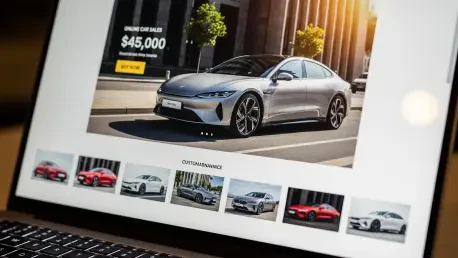The Rise of Online Car Buying: Industry Overview
Imagine a world where buying a car is as simple as ordering a book or a pair of shoes online, with just a few clicks delivering a vehicle to a nearby dealership for pickup. This scenario, once a distant dream, is rapidly becoming reality as the automotive e-commerce industry reshapes how consumers approach one of life’s major purchases. The digital transformation of car buying has gained significant momentum, driven by a growing demand for convenience and transparency in an industry historically known for complex negotiations and high-pressure sales tactics.
Digital platforms have emerged as pivotal tools in this shift, offering streamlined processes that allow buyers to browse inventory, compare prices, and even finalize purchases without stepping foot in a showroom. Technological advancements such as detailed vehicle history reports, virtual showrooms, and secure payment systems have further fueled this trend, making online car buying not just feasible but increasingly preferred. Major players like Amazon Autos, alongside competitors such as Carvana and Vroom, are at the forefront, leveraging cutting-edge technology to redefine consumer expectations in the automotive retail space.
The scope of online car sales in the U.S. is expanding rapidly, with millions of transactions now occurring through digital channels. Market data indicates a notable consumer shift toward these solutions, as buyers prioritize ease of access and the ability to research extensively before committing. This evolving landscape underscores a broader trend: the automotive industry is no longer just about physical dealerships but about creating seamless, user-friendly experiences that cater to a tech-savvy audience seeking control over their purchasing journey.
Amazon Autos: A Game-Changer in Digital Car Sales
Key Features and Recent Expansions
Amazon Autos has swiftly positioned itself as a transformative force since its initial launch, starting with an exclusive focus on new Hyundai vehicles. This partnership allowed buyers to select and purchase cars online, with the convenience of picking them up at local dealerships. The platform’s early model emphasized simplicity, cutting through the traditional complexities of car buying by integrating Amazon’s renowned e-commerce framework into the automotive space.
More recently, the platform has broadened its offerings to include used and certified pre-owned Hyundai vehicles, as well as non-Hyundai inventory listed by participating dealerships. This expansion, which began in Los Angeles, reflects a strategic response to consumer demand for greater variety and affordability. Unique features such as transparent pricing, comprehensive vehicle history reports, a three-day return policy, and acceptance test drives set Amazon Autos apart, ensuring buyers feel confident in their decisions. Plans are underway to extend this model across additional U.S. cities, signaling a commitment to nationwide accessibility.
The geographic rollout highlights a phased approach, with an initial focus on key markets before scaling further. Beyond just inventory expansion, the platform integrates customer-centric tools like dealership reviews and no-hidden-fee guarantees, addressing common pain points in car buying. This combination of innovation and practicality underscores Amazon Autos’ ambition to not only compete but lead in the digital automotive marketplace.
Market Impact and Consumer Response
Currently, Amazon Autos reaches 130 U.S. cities for new vehicle sales, demonstrating significant market penetration in a relatively short time. Consumer feedback has been overwhelmingly positive, with Net Promoter Scores exceeding industry averages, a clear indicator of satisfaction with the platform’s user experience. Buyers appreciate the ability to filter searches by location, condition, and brand, ensuring relevance to their specific needs within a 75-mile radius.
Market trends further validate this approach, as demand grows for diverse vehicle options and omnichannel experiences that blend online research with in-person interactions. The inclusion of non-Hyundai brands like Ford and Toyota through Hyundai dealerships caters to this need for variety, broadening the platform’s appeal. Such adaptability suggests that Amazon Autos is not merely reacting to trends but actively shaping them by prioritizing consumer choice.
Looking ahead, these developments position Amazon Autos as a potential market leader, capable of setting new standards for how cars are bought and sold digitally. The platform’s emphasis on trust-building features and seamless integration with local dealerships creates a robust ecosystem that could redefine industry benchmarks. As consumer preferences continue to evolve toward digital-first solutions, Amazon Autos appears well-equipped to maintain its competitive edge.
Challenges in Scaling Online Car Buying Platforms
Scaling a platform like Amazon Autos is not without obstacles, particularly when it comes to onboarding new dealerships. Capacity constraints within internal processes have created bottlenecks, limiting the speed at which new partners can join the marketplace despite high interest from Hyundai dealers nationwide. This challenge highlights the need for streamlined systems to handle rapid growth without compromising service quality.
Technological hurdles also play a role, as maintaining a seamless user experience across diverse inventory and geographic locations requires robust infrastructure. Variations in dealership systems, inventory data accuracy, and regional preferences must be addressed to ensure consistency for users browsing the platform. Overcoming these issues demands continuous investment in software updates and user interface enhancements to keep the experience intuitive and reliable.
Additionally, competition from other digital platforms and traditional dealership models poses a persistent threat. While online marketplaces offer convenience, many consumers still value the tactile experience of visiting a showroom, and established competitors have their own loyal customer bases. To counter this, Amazon Autos could explore strategic partnerships with more manufacturers and improve internal workflows, ensuring scalability while maintaining a focus on customer and dealer satisfaction.
Navigating the Regulatory Landscape of Digital Car Sales
The regulatory environment for online car sales in the U.S. presents a complex framework that platforms like Amazon Autos must navigate carefully. State-specific dealership laws vary widely, often dictating how vehicles can be sold and who can facilitate transactions, creating a patchwork of compliance requirements. Adhering to these rules is critical to avoid legal pitfalls and ensure smooth operations across different regions.
Compliance with transparency and consumer protection standards forms another cornerstone of this landscape. Buyers expect clear information about pricing, vehicle conditions, and return policies, and any misstep can erode trust. Amazon Autos has made a concerted effort to meet these expectations by vetting dealers thoroughly and enforcing strict guidelines for customer treatment, setting a high bar for accountability in digital sales.
Potential regulatory changes could further impact growth, either by easing restrictions on online transactions or introducing new hurdles. Staying ahead of such shifts requires proactive engagement with policymakers and industry bodies to advocate for frameworks that support innovation while protecting consumers. The ability to adapt to evolving regulations will be a key determinant of long-term success for platforms operating in this space.
The Future of Online Car Buying with Amazon Autos
Emerging technologies hold immense potential to elevate the Amazon Autos platform even further, with AI-driven personalization standing out as a game-changer. Tailoring vehicle recommendations based on user preferences, browsing history, and budget could enhance the shopping experience, making it more intuitive and efficient. Such advancements would likely deepen customer engagement and drive higher conversion rates.
Market disruptors, including new entrants and shifting consumer preferences for digital-first interactions, also shape the horizon. As younger generations accustomed to e-commerce dominate the car-buying demographic, the demand for fully integrated online-to-dealership journeys will intensify. Amazon Autos must continue innovating to stay ahead, potentially by incorporating virtual reality test drives or expanding financing options directly on the platform.
Global economic conditions add another layer of influence, as fluctuations in consumer spending power affect automotive retail trends. Economic downturns might push buyers toward more affordable used vehicles, a segment Amazon Autos is already addressing. By staying attuned to these broader dynamics and fostering a culture of innovation, the platform can solidify its role as a pioneer in transforming how cars are purchased in the digital age.
Conclusion: Redefining Car Buying for the Digital Age
Looking back, Amazon Autos has carved a significant path in reshaping the car-buying experience by prioritizing choice, transparency, and convenience for millions of users. Its journey reflects a bold vision to merge e-commerce prowess with automotive retail, creating a model that challenges conventional dealership norms. The platform’s high customer satisfaction scores and expanding reach underscore its impact on an industry ripe for disruption.
For stakeholders, the next steps involve embracing digital tools more fully to enhance outcomes. Dealers are encouraged to invest in training for online sales integration, ensuring they can meet the expectations of a digitally savvy audience. Consumers, meanwhile, can leverage platforms like Amazon Autos to gain better control over their purchasing decisions, using available data and reviews to make informed choices.
Future considerations point toward deeper collaboration between technology providers and automotive players to build even more seamless buying experiences. Exploring untapped markets and refining scalability challenges remain critical areas for growth. The broader implication is clear: e-commerce integration in traditional sectors like automotive retail has only just begun, promising a landscape where innovation will continue to drive profound change.









